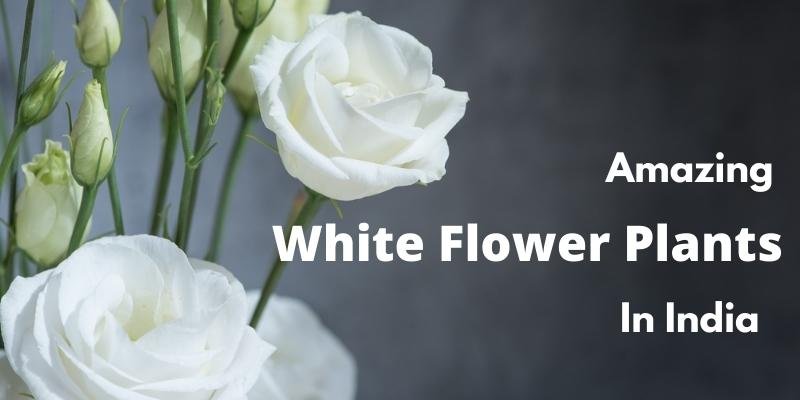Not only are these white flower plants easy to grow in India, but some of them offering the perfect blend of beauty and fragrance. Different flowers are the real gifts of nature due to their colours and textures.
Amazing white flowers symbolize purity, innocence and give a contrasting accent to colourful flowers. White flower plants have many benefits, including enhancing the beauty of a garden by design.
The following list shows white flower plants that grow in India. Some of them are popular in every region of India, while some are rare to see.
Popular White Flower Plants
1. White Bougainvillea

Scientific Name: Bougainvillea glabra
Plant Type: Annual plant
Sun needs: Full Sun
The waxy flowers of bougainvillea are surrounded by bracts that are often confused with petals. Growing in clusters, its flower production is continuous throughout the year.
The height of this flower plant is around 1 to 12 meter. This white flower plant is easy to grow with low maintenance. You need to put fertilizer once in a month during summer season. It has amazing benefits.
2. White Hibiscus

Scientific Name: Hibiscus rosa-Sinensis
Plant Type: Perennial plant
Sun needs: Direct Sunlight
Hibiscus’ trumpet-shaped flowers come in a variety of colours. In all, this white flowering plant is considered very sacred. It is also a symbol of attractiveness and feminine energy. White Hibiscus plant prefers a temperature of between 60 and 90 fern heat.
Interestingly, it has been used for medicinal purposes since ancient times. They need full sunlight to grow well. You can also make tea, jams, and salads from white hibiscus flowering plants.
3. White Water Lily
Scientific Name: Nymphaea alba
Plant Type: Aquatic plant
Sun needs: Direct Sunlight
White Water Lily plant is also known as white nenuphar. It belongs to the Nymphaeaceae family. Water lilies live in reservoirs such as green lakes and ponds. This bowl-shaped green has 16–20 petals and a large mass of yellow stamens in the center.
White Water Lily has a special importance in Buddhism and Hinduism, because the flowers close at night and reopen in the morning. The leaves of this plant are approximately 8 inches wide. Moreover, it is a symbol of pleasure and peace.
4. Calla Lily
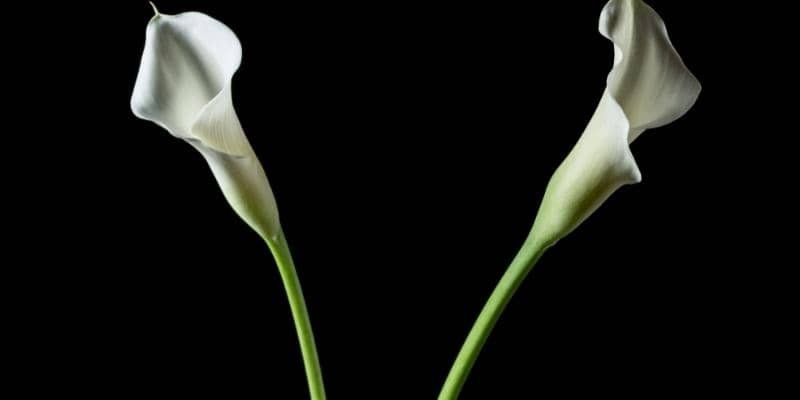
Scientific Name: Zantedeschia aethiopica
Plant Type: Bulbous perennials plant
Sun needs: Full sun or partial shade
The flower has chasm-shaped brackets that encircle the yellow spikes of the flowers. These velvety brackets, also known as spathes, are more inclined to one side, making their overall appearance attractive.
Calla Lily requires full sunlight or shady climates to grow quickly. It helps to improve the quality of air as it absorbs carbon dioxide from the surrounding area and releases oxygen into the atmosphere. It will take around 1 year to reach its mature phase.
5. Plumeria
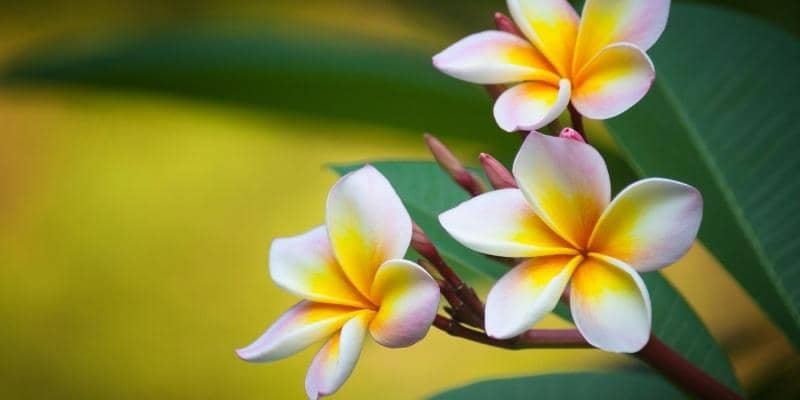
Scientific Name: Plumeria alba
Plant Type: Deciduous shrubs
Sun needs: Direct Sunlight
This white flowering plant is locally known as Champa. A Plumeria is a white, five-lobed flower with a yellow shade in the center. This white champa flower is very fragrant and flowers from early summer to late autumn.
So, it needs full sun. Along with this, you need to change the water every 2 to 3 weeks. This white-flowering plant is a native of the tropical climate.
6. White Tulip

Scientific Name: Tulipa gesneriana
Plant Type: Perennial Plant
Sun needs: Full Sun
The tulip is popular for its variety of rainbow colours, but when it comes to the white tulip; its story is completely different.
Symbolizing a new beginning, this cup-shaped flower is white with three petals and a sapling. The lifespan of this white flowering plant is a maximum of 10 years. It requires soil with a lot of organic matter.
7. White Rose

Scientific Name: Rosa × alba
Plant Type: Perennial Plant
Sun needs: Full Sun
Demonstrating innocence and purity, the visible flower is covered with several wax petals. The flower has a pleasant aroma and grows on prickly twigs. It is one of the finest white-flowering plants in India. It is a symbol of love and purity.
8. White Orchid

Scientific Name: Bauhinia acuminata
Plant Type: Perennial Plant
Sun needs: Full Sun
Demonstrating innocence and purity, the visible flower is covered with several wax petals. The flower has a pleasant aroma and grows on prickly twigs. It is one of the finest white-flowering plants in India. It is a symbol of love and purity.
9. White Carnation
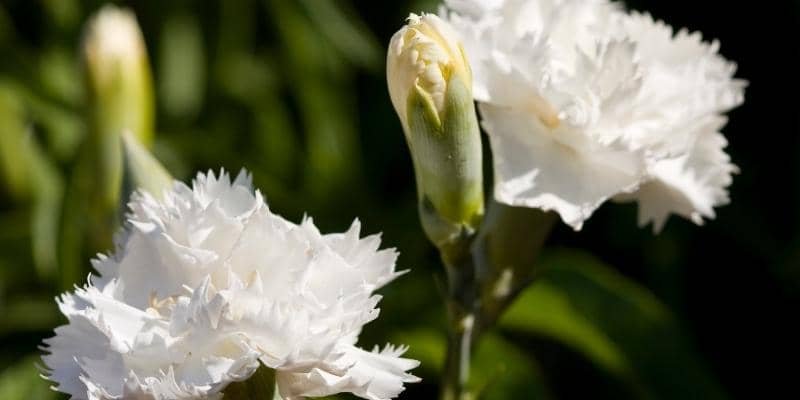
Scientific Name: Dianthus caryophyllus
Plant Type: Perennial Plant
Sun needs: Full Sun
The ruffled petals of the white avatar arranged in the shape of a pompom look stunning. His extravagant looks are an inspiration to many artists and poets. The maximum varieties give only one flower per stem.
10. White Gerbera Daisy

Scientific Name: Gerbera jamesonii
Plant Type: Perennial Plant
Sun needs: Full Su
The Gerbera daisy has slender petals with yellow eyes. This white flower is used for decoration on special occasions. Moreover, you can show your love and care towards your near and dear ones by representing this white flowering plant, as it symbolizes love and purity.
11. White Dahlia Flower
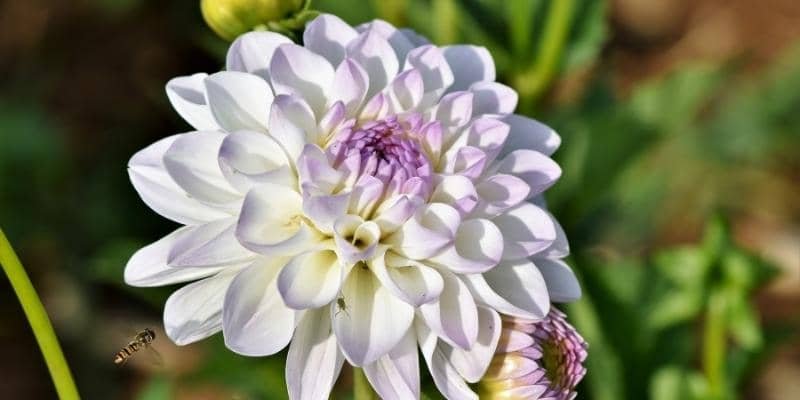
Scientific Name: Dahlia pinnata
Plant Type: Perennial Plant
Sun needs: Full Sun
It requires full sunlight for approximately 6 to 8 hours per day. You can grow this plant in small containers or pots. It is considered poisonous for pets and animals, so keep it away from them.
You need to give water once or twice a week, as it requires a lot of water. From April to May is the best time period for planting this white flowering plant.
12. White Clematis

Scientific Name: Clematis ligusticifolia
Plant Type: Perennial Vine
Sun needs: Full Sun
Clematis receives much acclaim for its stunning appearance, but also for its vanilla scent. Pure white flowers with yellow stamens are produced in the hot months of April and May.
These white flowering plants need full sunlight. The height of white clematis is 20 to 30 feet. Therefore, it needs 24 to 30 inches of space to grow. Neutral soil is suitable for growing this flowering plant.
You need to change the water every week. Between spring and autumn is the most appropriate time period for growing this white flowering plant.
13. Tuberose
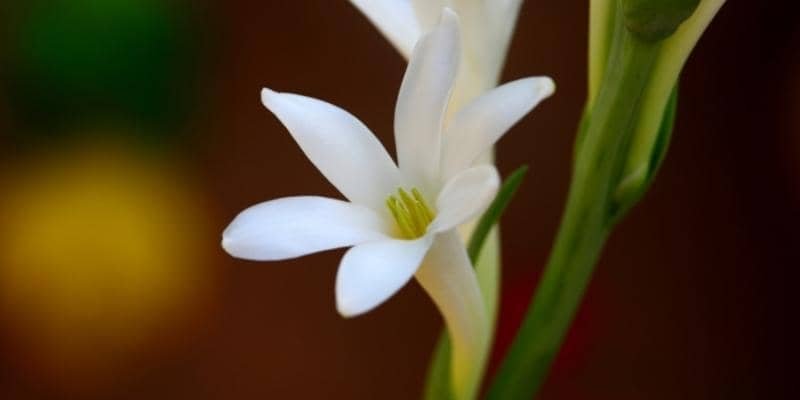
Scientific Name: Polianthes tuberosa
Plant Type: Tuberous perennial
Sun needs: Full Sun
The pride of India, turf is a waxy white flower that blooms in clusters on top of stems. This night bloomer emits a sweet aroma like honey, which is useful in extracting essential oils. It needs full sun.
Spring is the best time for planting tuberose. You need to check the upper surface of the soil. If you feel it is dry, then you should water the plant. At the beginning of the growing season, it requires a balanced fertilizer such as 10-10-10.
14. Candytuft
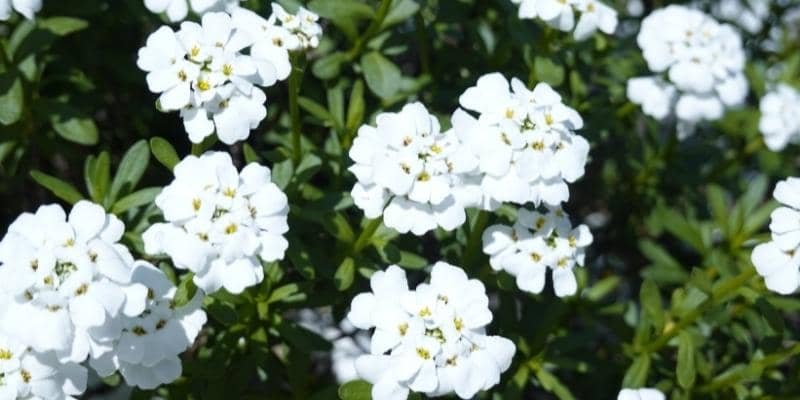
Scientific Name: Iberis amara
Plant Type: Perennial or annual
Sun needs: Full Sun
This is a low-growing plant that looks like a dense carpet in any garden. Flowers grow during winter and spring, surrounded by leaves that look like needles. It attracts bees and butterflies to the landscape. It is a non-toxic plant for everyone. Apart from this, it is also used in medical fields.
15. Cosmo

Scientific Name: Cosmos bipinnatus
Plant Type: Annual Plant
Sun needs: Direct Sunlight
The whole flower itself is a wide range of flowers. A ray of the floret drapes into a spherical shape with petals, while in the center of the flower is a disc florate.
Interestingly, early summer is the best flowering season for this flowering plant. Full sunlight is necessary for growing this plant. The height of this plant is at least 1 meter.
Every plant has its own importance, but flowering plants are more popular than other types of plants.
All of the plants mentioned above are white flower plants. They enhance the beauty of your garden and your home as well. They symbolize peace, love, innocence, and so on.
16. Night Jasmine
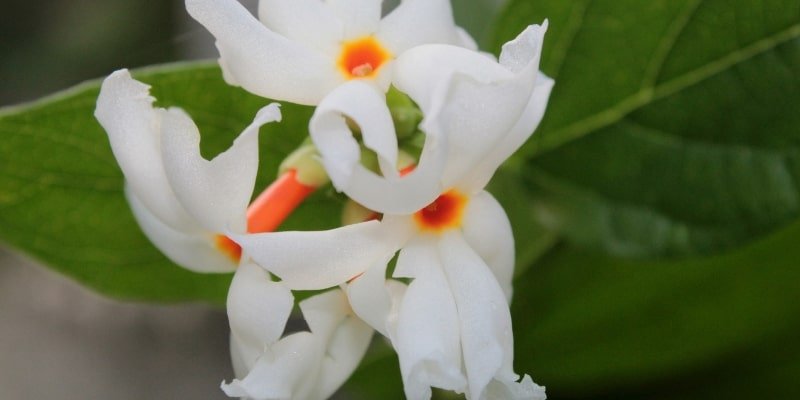
Scientific Name: Nyctanthes arbortristis
Plant Type: Annual Plant
Sun needs: Full Sun
The woody plant known as “night-blooming jasmine” (Cestrum nocturnum) grows quickly. The tubular greenish-white or yellow flowers, which attract butterflies and other pollinators and release a strong fragrance at night, are what give it its name.
The shrub blooms continuously throughout the summer, giving it a long blooming season. The shrub spreads out easily and can be grown from seed in the spring.
It’s frequently cultivated in patio containers or as a dense border hedge despite its aggressive invasive characteristics (some experts call it a “garden thug”).
17. Devil’s trumpet
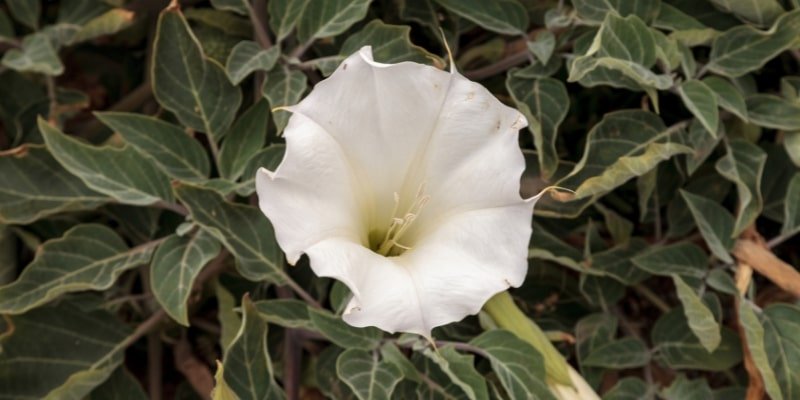
Scientific Name: Datura stramonium
Plant Type: Perennial Plant
Plant size: 3m
Sun needs: Full Sun
Angel’s trumpet grows in normal soil, but it likes full sun over partial shade and rich, wet, well-drained soil. It is tolerant of sandy or alkaline soil, but it struggles in complete shade.
On the other hand, seeds can be planted indoors six to eight weeks prior to the final spring frost, and plants can be put outside after that period. Since plants spread out, they should be separated three feet apart or supported by stakes.
While deadheading flowers is not required, if the plants are not deadheaded, self-seeding could happen. You can gather and save seeds for planting next spring.
18. Lily of the Valley

Scientific Name: Convallaria majalis
Plant Type: Perennial Plant
Sun needs: Full Sun to Part shade
The only species in the genus Convallaria within the asparagus family (Asparagaceae) is the fragrant perennial herb known as lily of the valley (Convallaria majalis). The plants can be used as ground cover and frequently grow closely together to make a dense mat.
The white bell-shaped flowers of the lily of the valley are borne in clusters on one side of a stalk devoid of leaves, and they nod. The two shiny leaves are typically found around the base of the plant.
19. Safed Kaner
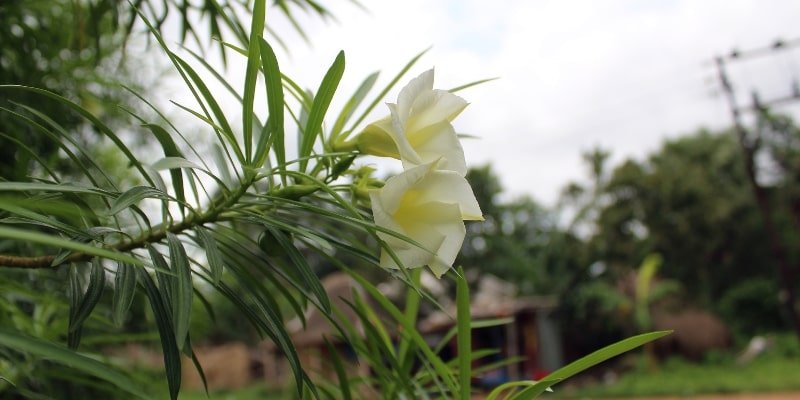
Scientific Name: Convallaria majalis
Plant Type: Perennial Plant
Sun needs: Full Sun
This flower has probably been spotted in your neighbourhood in parks, gardens, and temples. Because of the Kaner flower’s therapeutic qualities, you may have heard of it. Kaner is known scientifically as Cascabela thevetia. Kaner grows to a height of five metres and is an evergreen shrub or small tree.
At each branch’s terminal, clusters of blooms grow from the plant. Hindus attach considerable religious significance to the Kaner blossoms, which come in red, yellow, white, and pink.
20. Chrysanthemum

Scientific Name: Chrysanthemum morifolium
Plant Type: Herbaceous perennial
Sun needs: Full to mostly sun
The traditional fall flower is the chrysanthemum, sometimes known as “mums.” Being the Queen of the Autumn Flowers, Chrysanthemum x morifolium showcases jewel-like colours such as yellow, lavender, pink, purple, red, bronze, orange, and white.
Tiny flowers, known as florets, make up each bloom. If pinching occurs frequently during the growing season, chrysanthemums can reach a height and width of three feet.
Buds begin growing at bloom time, which is defined as 12 hours or less of daylight. When planted and spaced appropriately, chrysanthemums spread swiftly.
21. White Daffodil
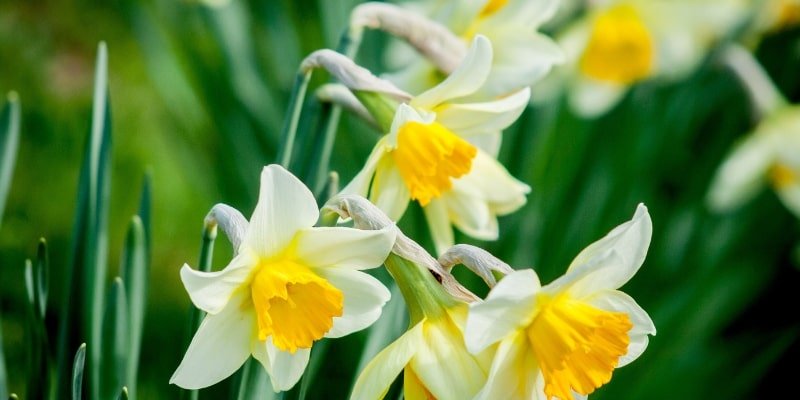
Scientific Name: Narcissus
Plant Type: Perennial
Sun needs: Full Sun
One of the most widely used and simple-to-grow perennial bulbs for spring blooms are daffodils (Narcissus spp.). Warmer weather encourages the blooming of these bulbs, which do well in areas where winter persists until spring arrives.
In warm climates, daffodils are usually bought as prechilled bulbs and planted as annuals. Daffodils are a popular flower for springtime since they are among the first to bloom in the early spring and represent hope and renewal.
Soon after the weather warms, clusters of strappy leaves appear, followed by trumpet-shaped, cup-shaped flowers.
22. White Begonia

Scientific Name: Begonia semperflorens
Plant Type: Perennial
Sun needs: Full Sun
Begonias can bloom for extended periods of time and require very little upkeep. These tropical plants are generally grown as indoor houseplants in cooler climes or as outdoor annuals throughout the summer.
They are frequently employed in outdoor container arrangements by landscapers because of their vibrantly coloured leaves and blossoms. These plants prefer soil that is somewhat acidic and partially shaded. Some animals could be poisoned by the roots.
23. White Annual Vinca
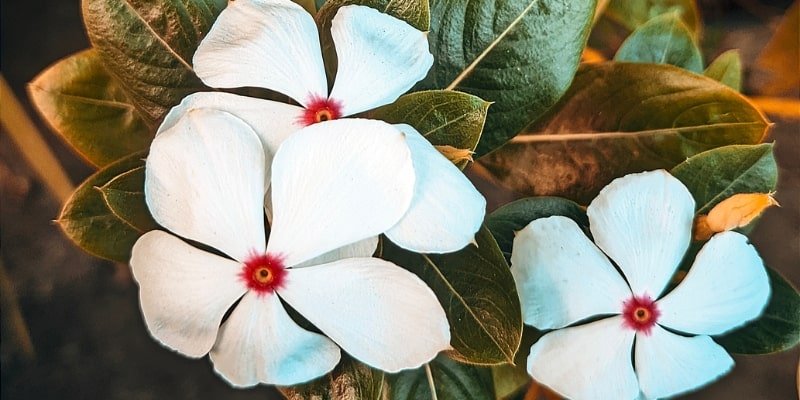
Scientific Name: Catharanthus roseus
Plant Type: Annual Plant
Sun needs: Full Sun
Most places cultivate annual vinca, or Catharanthus roseus, a tropical perennial that is planted as an annual. Although annual vinca resembles impatiens in both flowers and foliage, it prefers sunny spots and is not a fan of shade. The leaves have a leathery, dark green colour.
Vinca grows quickly; it can reach heights of 6 to 18 inches and spreads similarly, depending on the variety. From early July until the first frost, annual vinca plants produce solitary blooms with five petals that often touch or overlap.
24. White Amaryllis
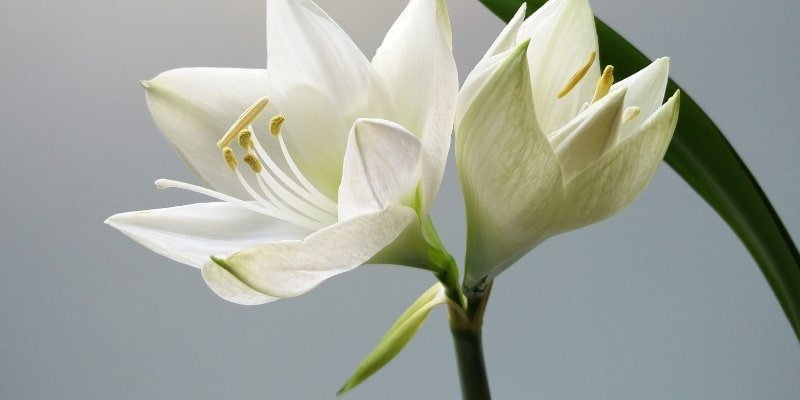
Scientific Name: Hippeastrum species
Plant Type: Bulbous plant
Sun needs: Full Sun
Though the bulbs can bloom at other times of the year, many people cultivate amaryllis bulbs so they can have plants bloom indoors in the winter.
Generally speaking, amaryllis blooms are hybrids of different species of the Hippeastrum genus, which is a collection of tropical plants native to Central and South America. Amaryllis plants are known for their trumpet-shaped blooms and strappy foliage.
The blooming period of your amaryllis should last at least seven weeks. There are substances in amaryllis bulbs, leaves, and stems that are poisonous to humans and animals.
25. White Camellia
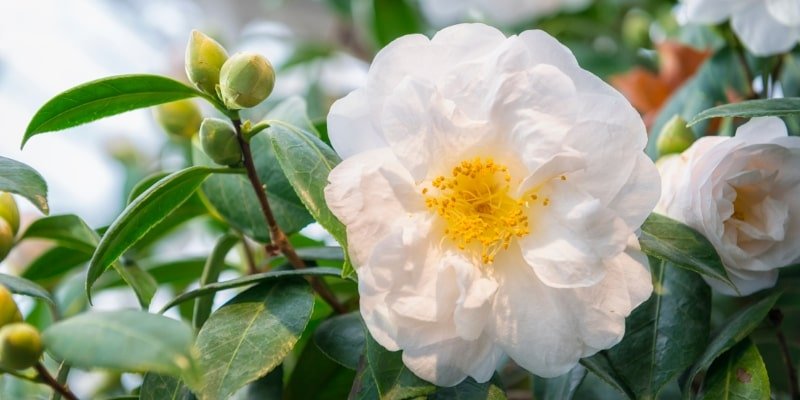
Scientific Name: Camellia Japonica
Plant Type: Evergreen shrubs
Sun needs: Dappled sunlight
During the autumn through early spring seasons in warmer climates, the camellia shrub blooms, producing big, luxuriant blossoms and glossy, black foliage. The blooms last for several weeks.
Notwithstanding the hottest summer months, camellias can be planted from nursery plants cultivated in containers virtually any time of year. The plants have remarkable longevity despite their modest growth.
26. Azalea
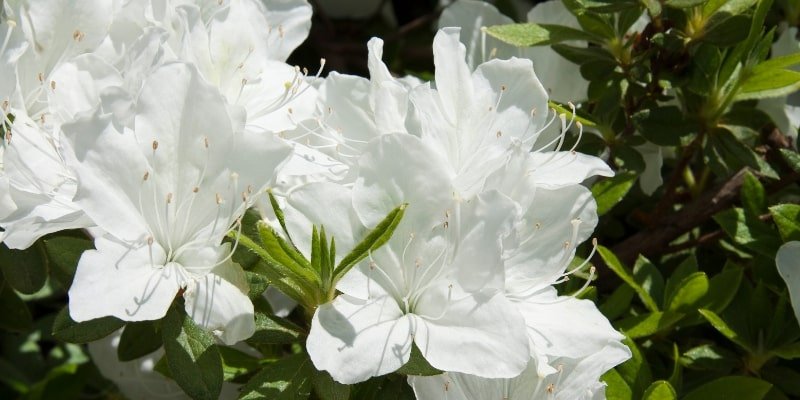
Scientific Name: Rhododendron
Plant Type: Shrubs
Sun needs: Direct Sunlight
Azaleas are evergreen or deciduous shrubs with elliptic leaves that prefer shade and have loose branches. Azaleas require midday shade in regions with hot summers and at least four hours of sunlight every day.
It is ideal to plant azalea shrubs in the spring or early autumn. Different species grow at different speeds, but most grow somewhat slowly. Typically, a one-gallon container plant will bloom in its first year of life, but it could take up to ten years for it to reach its maximum size.
27. Anemone

Scientific Name: Anemone
Plant Type: Perennial
Sun needs: Full Sun
Anemone, a collective term for a number of distinct species in the Anemone genus, is most commonly used to refer to windflowers. “Wind” is the translation of the Greek word “anemos.”
They all have basal leaf clumps from which long flower stems ascend to support fragile flowers; however, their sizes vary greatly. In more temperate locations, they grow well in moist soil and full to partial sun.
28. Candytuft

Scientific Name: Iberis
Plant Type: Perennial
Sun needs: Full Sun
Candytuft is a woody sub shrub that blooms and is sometimes mistaken for a perennial because of its clusters of tiny, pastel or white flowers with many petals.
Candytuft can withstand a range of temperatures and thrives in full to partial sun, well-draining soil of any pH, and drier, less humid environments. he has a mildly harmful effect on people.
More essentially, you must make sure they have good drainage. Candytuft is ideal for rock gardens since it prefers well-drained soils. Although it has good tolerance for both slightly acidic and neutral soils, this perennial prefers to be cultivated on ground with an alkaline pH.
29. Magnolia

Scientific Name: Magnolia grandiflora
Plant Type: Evergreen Shrubs
Sun needs: Full sun to light shade
You may help the magnolias you recently planted in your yard establish themselves by preventing soil compaction in the vicinity of the root zone. Try your best to reduce the amount of foot traffic near the base of the tree.
They are also not frequently grazed by deer or other wild garden visitors. Magnolias grow well in mild shade or full sun with consistent watering. Ensure that the soil beneath your magnolia receives enough moisture and proper drainage.
In most cases, magnolias cannot thrive in damp soil. One exception is sweet bay (M. virginiana), which thrives in moist conditions.
30. Gardenia
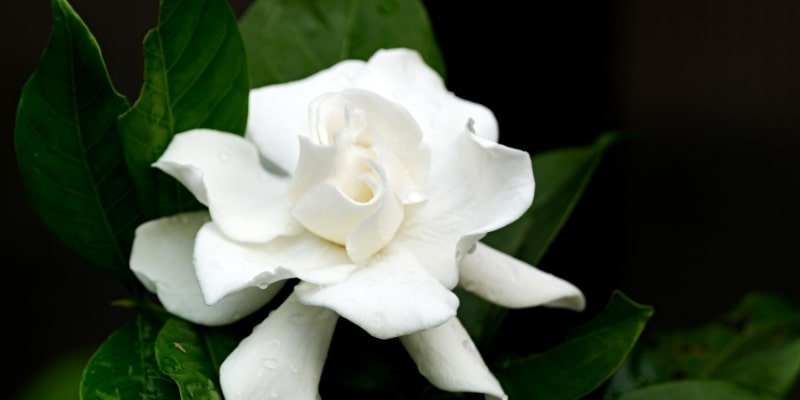
Scientific Name: Gardenia jasminoides
Plant Type: Evergreen Shrubs
Sun needs: Full sun to Partial Shade
The tropical broadleaf evergreen shrub Gardenia (Gardenia jasminoides) is commonly grown as a large interior houseplant due to its wonderful scent during bloom. Actually, not many natural smells are as potent and unforgettable as this beloved plant’s aroma.
Few gardeners would attempt to grow the high-maintenance gardenia, which is often seen only in conservatories and commercial greenhouses, if it weren’t for the plant’s fragrance allure. Still, even a few months of blossoms makes the effort worthwhile if you’re up for the challenge.
Conclusion
I hope you liked reading the guide. If you think we have missed something or have any suggestions, please drop your valuable opinion in the comment section below.
If you are searching fresh and live houseplants online then checkout our extensive collection of amazing indoor and outdoor houseplants.

